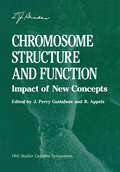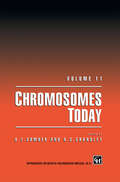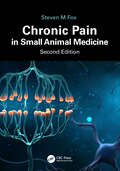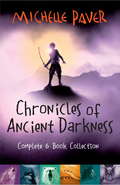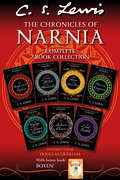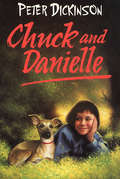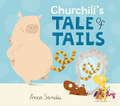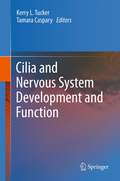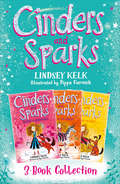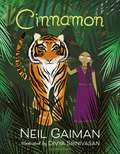- Table View
- List View
Chromosome Damage and Repair (Nato Science Series A: #40)
by Erling SeebergThe NATO - EMBO Advanced Study Institute - Lecture Course on "CHROMOSOME DAMAGE AND REPAIR" was held at God¢ysund Fjord Hotel outside Bergen, Norway. from Ms\r 27th to June 5th, 1980. This book represents the proceedings of this meeting. In addition to the for mal lectures, a number of short contributions presented in the dis cussion sessions following the lectures are also included. The papers have been divided into different groups according to topic, essentially in the same way as they were presented during the meet ing. The editors have m. ade' few alterations in the manuscript sub mitted and these were mostly confined to typing style and correc tion ot typographical errors. We would like to express our appreciation to all the persons who helped in making this meeting possible. Special thanks are due to Tomas Lindahl, Alan R. Lehmann and Erik Boye, who served in the advisory program committee. We would also like to thank our Danish friends and colleagues and others who provided invaluable assistance in an emergency situation. The editors are also grateful for the financial support provided by a number of organizations and institu tions. First and foremost of these were the NATO Scientific Affairs Division and the European Molecular Biology Organization.
Chromosome Structure and Function: Impact of New Concepts (Stadler Genetics Symposia Series)
by Rudi Appels J. Perry GustafsonA Historical Perspective on the Study of Chromosome Structure and Function R. Appels Division of Plant Industry CSIRO P.O. Box 1600 A.C.T. AUSTRALIA "Modern physical science gives us no model to explain the re duplication of the gene-string in each cell generation, or to ex plain the production of effective quantities of specific enzymes or other agents by specific genes. The precise pairing and inter change of segments by homologous gene-strings at meiosis also suggest novel physical properties of this form of matter". Stadler (1954) The very strong influence of reductionism in the history of understanding chromosome structure and function is evident in the above quotation from Stadler's 1954 paper, "The gene". Earlyob servations on the constancy of the cytological appearance of chromo somes and their regular behaviour in cell division led to specula tion on their biological importance. As genetics became more refined in the early decades of the 20th century the genes-on-a string model of chromosomes developed and greater emphasis was placed on the further dissection of these structures. As a result, in the 1980's the reductionist approach is reaching a crest as extensive regions of the genetic material are being sequenced.
Chromosomen: Klassische und molekulare Cytogenetik (Springer-Lehrbuch)
by Walther TrautChromosomen sind für lange Zeit ein Gegenstand der reinen Grundlagenforschung gewesen. Mit Entdeckung der Chromosomenanomalien beim Menschen hat sich eine immer größer werdende, angewandte Forschungsrichtung, die klinische Cytogenetik, entwickelt und zusätzliches Interesse am Bau und der Funktion der Chromosomen geweckt. Heute vollzieht sich eine sprunghafte Erweiterung unserer Kenntnisse von dem licht- und elektronenmikroskopischen zum molekularen Niveau. Wegen der vollständig verschiedenen Techniken klafft im Verständnis häufig eine Lücke zwischen den beiden Gebieten. Das Buch bietet dem molekular orientierten Studenten und Forscher eine Übersicht über die Struktur und dem morphologisch Orientierten eine Übersicht über die molekularen Erkenntnisse. Es macht die Kontinuität der Forschung und der Fortschritte auf diesem Gebiet deutlich.
Chromosomes Today: Volume 12
by N. Henriquez-Gil J. S. Parker M. PuertasChromosomes Today Volume 12 records the plenary proceedings of the 12th triennial International Chromosone Conference, presenting an overview of the current concerns in the developing studies of animal, plant and human cytogenetics. As well as giving an accurate historical record of the achievements in chromosome studies, this important series points the way forword, emphasizing the areas in which new developments will take place. Volume 12 explores the complete integration of molecular biology and cytogenetics, evaluating the concensus of the world's cytogeneticists concerning the nature and activities of the chromosome.It reinforces our view of the chromosome as the genetic organelle whose structure, behaviour and modification underlie our modern concept ofeukaryote genetics.
Chromosomes Today: Volume 11
by A. T. Sumner A. C. ChandleyWhen the late Professor C. D. Darlington founded what developed into the International Chromosome Conferences in Oxford in 1964, he was concerned that scientists who worked on different aspects of chromosomes, or who studied them in different ways, should have the opportunity of "discussing the fundamental problems of chromosomes with one another". The fact that well over 300 scientists with a wide variety of interests came to Edinburgh in August 1992 for the 11th International Chromosome Conference shows that there is still the same need, and also the desire among chromosomologists to have such discussions. The present volume contains almost all the invited contributions, and attests to the diversity of approaches and applications in chromosomal studies. A few years ago it may have seemed to some that chromosome studies were being superseded by molecular biology, but the molecular biologists have now realized that they need to know about chromosomes, and indeed an important, if ill-defined discipline of 'molecular cytogenetics' has grown up in recent years. We are pleased that in planning the Conference and this book, so much of the work presented is at the interface between cytogenetics and molecular biology. This will surely continue in the future, as boundaries between disciplines are largely artificial, and each has much to learn from the others.
Chronic Disease Management for Small Animals
by W. Dunbar Gram Rowan J. Milner Remo LobettiPractical guidance on managing chronic illnesses in small animals Chronic Disease Management for Small Animals provides a complete resource for the long-term care and therapy of canine and feline patients with incurable conditions. Offering practical strategies for successful management of chronic disorders, the book presents expert guidance on handling these ailments and the animals that they afflict. Written by leading experts in their respective fields, Chronic Disease Management for Small Animals takes a multidisciplinary approach to the subject, covering chronic diseases across many categories, including mobility, dermatology, ophthalmology, internal medicine, and more. The book is not meant to replace existing textbooks, but is designed to be used as a practical guide that educates the reader about the many therapeutic options for chronic disease management. Coverage encompasses: The impact that chronic disease has on the quality of life for both the patient and its owner Specific chronic diseases, outlining diagnostics, therapeutics, and quality of life concerns Hospice care and end of life, including client and pet needs, quality of life, cultural sensitivities, dying naturally, euthanasia, and death Chronic Disease Management for Small Animals is an essential reference for recently qualified and seasoned practitioners alike, supporting clinicians in making decisions and communicating with clients regarding long-term care. It is an ideal book for all small animal practitioners and veterinary students.
Chronic Disease Management for Small Animals
by W. Dunbar Gram Rowan J. Milner Remo LobettiPractical guidance on managing chronic illnesses in small animals Chronic Disease Management for Small Animals provides a complete resource for the long-term care and therapy of canine and feline patients with incurable conditions. Offering practical strategies for successful management of chronic disorders, the book presents expert guidance on handling these ailments and the animals that they afflict. Written by leading experts in their respective fields, Chronic Disease Management for Small Animals takes a multidisciplinary approach to the subject, covering chronic diseases across many categories, including mobility, dermatology, ophthalmology, internal medicine, and more. The book is not meant to replace existing textbooks, but is designed to be used as a practical guide that educates the reader about the many therapeutic options for chronic disease management. Coverage encompasses: The impact that chronic disease has on the quality of life for both the patient and its owner Specific chronic diseases, outlining diagnostics, therapeutics, and quality of life concerns Hospice care and end of life, including client and pet needs, quality of life, cultural sensitivities, dying naturally, euthanasia, and death Chronic Disease Management for Small Animals is an essential reference for recently qualified and seasoned practitioners alike, supporting clinicians in making decisions and communicating with clients regarding long-term care. It is an ideal book for all small animal practitioners and veterinary students.
Chronic Pain in Small Animal Medicine
by Steven M. FoxOver the past decade, since publication of the first edition of Chronic Pain in Small Animal Medicine, many advances have been made in the discipline of pain management, including embracement under the One Medicine initiative to improve the health and well-being of multiple species. Contributing significantly to this progress is the evidence base provided by multimodal management of chronic diseases such as osteoarthritis, a leading cause of pet euthanasia. These advances are explored in this updated edition, written for the veterinary professional seeking a greater depth of knowledge in the mechanisms of pain accompanying chronic disease states and the potential targets for treatment. Additional new sections describe newer drugs that are now in wide use, the Canine Osteoarthritis Staging Tool (COAST), novel approaches to cancer treatment, and cannabinoids and their functions. The book goes beyond common protocols by focusing on the latest evidence and our understanding of 'why and how to treat'. It describes and evaluates current physiological and biochemical theories of pain transmission without losing sight of the practical need for such information. Chronic Pain in Small Animal Medicine provides a foundation for advances in animal care and welfare and is necessary reading for veterinarians in practice and training. We’re living in an age of exciting, new discoveries, but these are only exciting if we are aware of these offerings and their optimal indications for use. This book aims to open veterinarians' eyes to the myriad new ways we can now treat chronic pain in small animals.
Chronic Pain in Small Animal Medicine
by Steven M. FoxOver the past decade, since publication of the first edition of Chronic Pain in Small Animal Medicine, many advances have been made in the discipline of pain management, including embracement under the One Medicine initiative to improve the health and well-being of multiple species. Contributing significantly to this progress is the evidence base provided by multimodal management of chronic diseases such as osteoarthritis, a leading cause of pet euthanasia. These advances are explored in this updated edition, written for the veterinary professional seeking a greater depth of knowledge in the mechanisms of pain accompanying chronic disease states and the potential targets for treatment. Additional new sections describe newer drugs that are now in wide use, the Canine Osteoarthritis Staging Tool (COAST), novel approaches to cancer treatment, and cannabinoids and their functions. The book goes beyond common protocols by focusing on the latest evidence and our understanding of 'why and how to treat'. It describes and evaluates current physiological and biochemical theories of pain transmission without losing sight of the practical need for such information. Chronic Pain in Small Animal Medicine provides a foundation for advances in animal care and welfare and is necessary reading for veterinarians in practice and training. We’re living in an age of exciting, new discoveries, but these are only exciting if we are aware of these offerings and their optimal indications for use. This book aims to open veterinarians' eyes to the myriad new ways we can now treat chronic pain in small animals.
Chronic Pain in Small Animal Medicine
by Steven M. FoxChronic pain is unlike acute pain, it lasts beyond the time necessary for healing and resists normal treatment. No one patient feels pain in the same way and yet in veterinary medicine the patient's gain is generally assessed based on a single standard.There is an increasing focus in veterinary medicine on measuring and resolving pain and suffering
Chronicles of Ancient Darkness Complete 6x EBook Collection: Wolf Brother; Spirit Walker; Soul Eater (Chronicles of Ancient Darkness #29)
by Michelle PaverThe complete six adventures in Torak's quest to vanquish the terrifying Soul-Eaters - Wolf Brother, Spirit Walker, Soul Eater, Outcast, Oath Breaker and the award-winning final volume, Ghost Hunter.
The Chronicles of Narnia 7-in-1 Bundle with Bonus Book, Boxen (The Chronicles of Narnia)
by C. S. LewisThis collection contains all seven books in the classic fantasy series, The Chronicles of Narnia, without art, to appeal to older readers. This special ebook edition includes an introduction by C. S. Lewis’s stepson, Douglas Gresham and full text and art for Lewis’s very first work – Boxen!
Chronische intracochleäre Elektrostimulation und ihr Einfluss auf das auditorische System
by Sebastian JansenSebastian Jansen untersucht den Einfluss von je drei unterschiedlichen Stimulationsraten und -intensitäten während einer einseitigen Elektrostimulation mittels einseitig mit Human-Cochlea-Implantat versorgten Meerschweinchen. Diese waren auf dem anderen Ohr normalhörend und wurden mit einer einseitig vertäubten, aber nicht elektrostimulierten Kontrollgruppe verglichen. Der Autor zeigt den Zusammenhang der verwendeten Stimulationsrate mit den in der zentralen Hörbahn gefundenen Zelldichten sowie zwischen den in der Elektrostimulation verwendeten Stimulationsintensitäten und den ermittelten Zelldichten auf.
Chrysanthemums: Beautiful varieties for home and garden
by null Naomi Slade null Georgianna LaneThe underestimated Chrysanthemum is the epitome of both flamboyance and style with it’s many varieties and shapes: chronicled beautifully in Naomi Slades Chrysanthemums. The next title in Pavilion’s best-selling series of stylish floral guides, Chrysanthemums celebrates the versatility and variety of this familiar yet surprising bloom. As a life-giving herb in ancient China, a cultural emblem in Japan and a design icon of the Arts and Crafts movement, the chrysanthemum has been lauded through the ages. Yet in recent years it has gained a reputation as something of a workhorse among cut flowers, thanks to its reliable, long-lasting blooms and sturdy stems. More recently, resurgent interest in heritage varieties and new developments in growing and propagating have meant that the future of the flower is changing. As a cut flower, the exotic, decadent blooms and adaptable sprays of buttons are winning hearts and attracting new admirers, while the hardy and tenacious garden varieties are experiencing a long-overdue resurgence. Chrysanthemums explores cultivated chrysanthemums in all their glory, from the rare and interesting to the glamorous and ubiquitous, via those that are simply excellent garden plants. It delights in their form, fragrance and colour, digs into their history and rejoices in one of the finest cut flowers around. The huge variety of the genus Chrysanthemum is illuminated in captivating text by gardening journalist, author and designer Naomi Slade, while the elegant and characterful blooms are captured in gorgeous colour by photographer Georgianna Lane. The chrysanthemum is the perfect flower for weddings, gift bouquets and to brighten your home, and with expert advice and commentary, this book is ideal for anyone wanting to propagate, grow, cut, or simply admire this fabulous bloom.
Chuck and Danielle
by Peter DickinsonChuck is a whippet. A very nervous whippet, who's scared of absolutely everything: paper bags, pigeons, supermarket trolleys, cats (even the little fluffy ones). Some people say Chuck's a wimpet, not a whippet, and Mum keeps pretending she's going to give Chuck away, but Danielle loves her scaredy-cat whippet and knows that there's more to Chuck than meets the eye... Seven funny, charming and totally whippet-friendly stories from Peter Dickinson, the winner of several major awards for his books for young readers - and the owner of three whippets!
Churchill's Bestiary: His Life Through Animals
by Piers Brendon'From beak to tail feather and from flipper to fin, this is a book that will long be known, read and savoured.' – James W. Muller, Chairman of the Board of Academic Advisers of the International Churchill SocietyWinston Churchill was known for his great love for and admiration of animals. In fact, one of Churchill’s key characteristics was his fascination with the animal kingdom – creatures of all sorts were a crucial element in his existence. He was amused, intrigued and enchanted by, sometimes even besotted with a vast menagerie, from his pet budgerigar, dogs, cats, fish, butterflies, to his own lion, leopard and white kangaroos kept at London Zoo, and even more unusual species. Dwelling and walking amid flora and fauna was Churchill’s ideal form of existence – ‘The world would be better off if it were inhabited only by animals’ – and he signed his letters home as a boy ‘The Pussy Cat’.In this fascinating biography, Dr Piers Brendon looks deeper into Churchill’s love of the animal kingdom, and at how animals played such a large part in his everyday life. We encounter the paradox of the animal-loving-hunter: he hunts foxes yet keeps them as pets, he likes fishing but loves fish; along with the man who used analogies to animals time and time again in his speeches and writings. The picture that emerges shows another side to the great man, showcasing his wit, wisdom and wayward genius from a different perspective and shedding new and fascinating light on the man voted The Greatest Briton.
Churchill's Tale of Tails
by Anca SanduChurchill is a pig with a big personality who couldn't be prouder of his perfect tail. Until one day it goes missing... So Churchill tries on a whole host of other tails - tails that make his personality even more colourful. But along the way, Churchill forgets what really matters most to him - his friends. Can Churchill learn to value his friendships and solve the mystery of his missing tail?
Cilia and Nervous System Development and Function
by Kerry L. Tucker and Tamara CasparyCilia are tiny microtubule-based organelles projecting from the plasma membrane of practically all cells in the body. In the past 10 years a flurry of research has indicated a crucial role of this long-neglected organelle in the development and function of the central nervous system. A common theme of these studies is the critical dependency of signal transduction of the Sonic hedgehog, and more recently, Wnt signaling pathways upon cilia to regulate fate decisions and morphogenesis. Both primary and motile cilia also play crucial roles in the function of the nervous system, including the primary processing of sensory information, the control of body mass, and higher functions such as behavior and cognition, serving as "antennae" for neurons to sense and process their environment. In this book we describe the structure and function of cilia and the various tissues throughout the brain and spinal cord that are dependent upon cilia for their proper development and function.
The Ciliated Protozoa: Characterization, Classification, and Guide to the Literature
by Denis Lynndistances between groups of ciliates were as vast as significant hurdles to obtain copyright permissions the genetic distances between plants and animals for the over 1,000 required illustrations, and I put – THE major eukaryotic kingdoms at that time! the publication schedule ahead of this element. I continued to collaborate with Mitch, and in There are a number of significant illustrated guides 1991 my first “molecular” Magisterial student, to genera and species that have recently been pub- Spencer Greenwood, published an article estab- lished. References are made to these throughout lishing 1990 or thereabouts as the beginning of the book as sources that readers can consult for this the “Age of Refinement” – the period when gene aspect of ciliate diversity. A future project that I am sequencing techniques would deepen our under- contemplating is an illustrated guide to all the valid standing of the major lines of evolution within ciliate genera.
Cinders & Sparks 3-book Story Collection: Magic At Midnight, Fairies In The Forest, Goblins And Gold (Cinders & Sparks)
by Lindsey KelkThis collection includes three Cinders & Sparks adventures. CINDERS AND SPARKS: MAGIC AT MIDNIGHT Cinders lives a boring life with her selfish stepsisters and mean stepmother. So when her wishes start magically coming true it’s a surprise to say the least. Then Cinders meets her fairy godmother: she’s magic, she can fly, and she’s called… Brian. CINDERS AND SPARKS: FAIRIES IN THE FOREST Cinders and her talking dog Sparks are on the run, in the Deep Dark Forest, after Cinders performed magic at the castle and made everyone think she was a witch. The hapless Hansel is on the run with them, but only because he ate some of an actual witch’s gingerbread house and she got cross. If they can reach Fairyland, maybe they’ll all be safe? CINDERS AND SPARKS: GOBLINS AND GOLD Cinders, her talking-dog, Sparks, a horse called Mouse, and Hansel continue their quest to find Fairyland. But even the bravest questers get hungry, and when the quartet stop at a market for lunch, calamity and chaos ensue!
Cinnamon
by Neil Gaiman Divya SrinivasanIn a hot, hot country, ringed with mountains on one side and jungle on the other, lives a princess called Cinnamon. Her eyes are made of pearls, which means that she is blind. And, for reasons her parents the Rajah and Rani cannot fathom, she will not talk. So they offer a reward to anyone who can teach Cinnamon to speak. People travel from far and wide to attempt it, but nothing works. Until a mighty tiger, huge and fierce, prowls into their palace and announces that he is here to teach the girl-cub to talk ...A mighty fable from Neil Gaiman, winner of the Newbery and Carnegie Medals, illustrated in vivid colour by up-and-coming talent Divya Srinivasan. Neil Gaiman's work has been widely adapted for film and TV, including films of Coraline and Stardust, and adaptations of American Gods, Good Omens (written with Terry Pratchett) and How to Talk to Girls at Parties are in the works for 2017.
Circadian Clocks: Methods and Protocols (Methods in Molecular Biology #2130)
by Steven A. BrownThis volume presents techniques used by researchers from all branches of biology to study daily changes at a molecular level in many physiological systems. The chapters are organized into three parts and cover topics such as measuring and modeling physiological and behavioral rhythms; genome-wide analyses in circadian biology, and imaging and manipulating brain clocks. Written in the highly successful Methods in Molecular Biology series format, chapters include introductions to their respective topics, lists of the necessary materials and reagents, step-by-step, readily reproducible laboratory protocols, and tips on troubleshooting and avoiding known pitfalls.Cutting-edge and practical, Circadian Clocks: Methods and Protocols is a valuable tool for any researcher interested in learning more about this developing field.
Circadian Clocks (Handbooks of Behavioral Neurobiology #12)
by Joseph S. Takahashi Fred W. Turek Robert Y. MooreThe Handbook of Behavioral Neurobiology series deals with the aspects of neurosciences that have the most direct and immediate bearing on behavior. It presents the most current research available in the specific areas of sensory modalities. This volume explores circadian rhythms.
Circadian Rhythms: Methods and Protocols (Methods in Molecular Biology #362)
by Ezio RosatoThis is an in-depth examination of circadian biology, presented by leading researchers in the field. Methods for analysis of rhythmic readouts in select model organisms are included. This cutting-edge collection of protocols is adaptable for research at every level, and represents the huge strides that chronobiologists have made over the past two decades. Circadian biologists at all research levels will realize tremendous benefit from this extraordinary collection.

